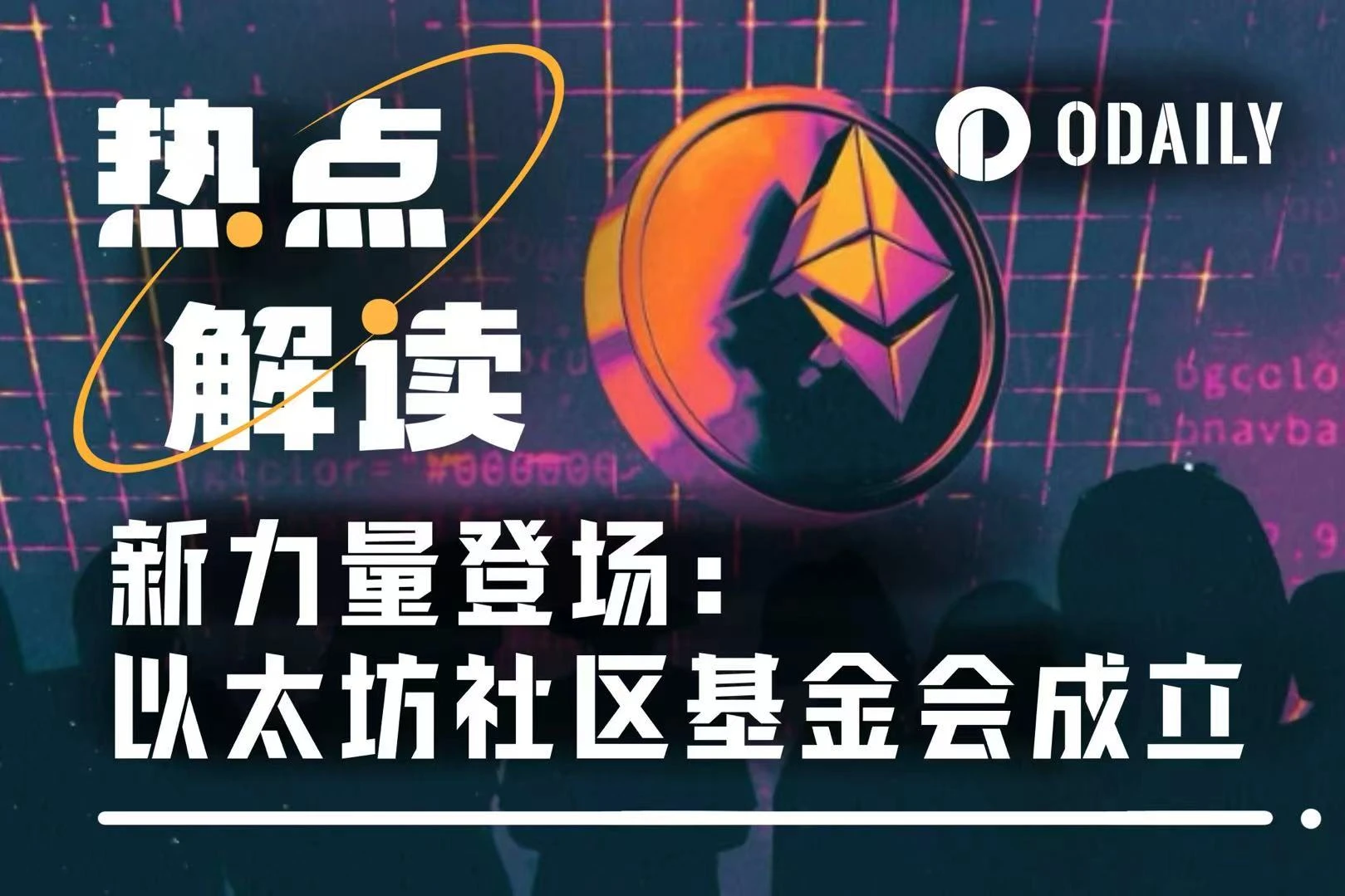Original | Odaily Planet Daily ( @OdailyChina )
Author | Dingdang ( @XiaMiPP )

On July 1, at the ETHCC conference in France, Ethereum core developer Zak Cole announced the establishment of the Ethereum Community Foundation (ECF), planning to push up the price of ETH and shouting the slogan ETH will rise to $10,000.
ETHs recent price performance is indeed good, especially in early May when it once soared by more than 40% in a single day. The short-term goal of returning to $3,000 seems to have become the obsession of the E Guards. But behind this craze, there is actually a deeper story of value attribution and self-healing.
ECF: A voice for coin holders
Zak Cole does not hide the positioning and ambition of ECF: “It is not an extension of the Ethereum Foundation (EF), but a new force aimed at ‘correction’. We say what EF dares not say and do what they are unwilling to do. We serve ETH holders because you deserve better.”
ECF’s mission is clear: to promote institutional adoption of Ethereum infrastructure, accelerate the ETH destruction mechanism, and increase the market value of ETH.
Currently, ECF has raised millions of dollars in ETH funds and plans to prioritize funding neutral, immutable, and token-free public technology projects, focusing on supporting tokenized real-world assets (RWA) and repairing key infrastructure such as the blob space pricing mechanism.
Despite the limited scale of fundraising, ECF has introduced a token voting mechanism in governance to ensure that the flow of funds is open and transparent. Its first funded project is the Ethereum Validator Association, which aims to provide resources and voice channels for the validator group and provide institutional guarantees for network operators. This move not only responds to the communitys demand for transparent governance, but also injects new vitality into the Ethereum ecosystem.
Ethereum Foundation’s old problems: centralization dilemma and transparency crisis
The birth of ECF is more like a clear challenge to the long-standing governance problems of the Ethereum Foundation.
The Ethereum Foundation, which was established 11 years ago, was once a solid backer of Ethereums development. However, in recent years, it has been criticized for being overly obsessed with long-term research and ignoring the short-term needs of users and developers. Even more unsatisfactory is its centralized governance structure and opaque decision-making mechanism.
Ethereum developer Péter Szilágyi once had a dispute with Tomasz Stańczak, co-executive director of the Ethereum Foundation. Szilágyi said that as a key member of the development team of Geth (Go Ethereum, the main client software of Ethereum), the foundation has proposed several times in the past to bid $5 million to allow the Geth team to separate from the foundation and operate independently. Similar fund allocations have also happened to Parity (another Ethereum client development company). The Ethereum Foundation has long adopted a diversified investment strategy for client development. The intention behind this may be to reduce the risk of single-point dependence, but this has also exacerbated the friction of internal resource allocation and power negotiation.
The greater governance confusion is reflected in the organizational structure of the Ethereum Foundation itself . Christine Kim, former vice president of Galaxy Digital, once publicly questioned the opacity of the EF organizational structure: Tim Beiko, Barnabé Monnot, Alex Stokes and others held multiple positions, juggling the dual tasks of coordinating L1 and L2 expansion and leading the RD team. In addition, Christine had doubts about the details of the architecture diagram, such as whether the bold names were team leaders, the purpose of the highlighted parts, and the confusion about the color grouping logic, such as why the consensus mechanism and account abstraction were grouped together, but stateless consensus was not included; why Testing and pandaops were grouped together, but Security was not grouped, all of which lacked clear explanations.
Another point that the Ethereum Foundation has been criticized for is its selling of coins. As a core supporter of the Ethereum ecosystem, EF has a large amount of ETH to maintain operations and fund development. However, community members are wondering why it chooses to sell directly instead of earning income through DeFi staking (such as Aave). Moreover, EFs selling of coins is often accompanied by the trend of ETH prices, making market sentiment sensitive and fragile. Some people believe that EFs selling is to cope with operating expenses; others worry that this may be a manifestation of a lack of strategic planning.
Data shows that the Ethereum Foundation spent as much as $134.9 million in 2023 to fund mainnet upgrades, zero-knowledge proofs and other projects, but delivered an unsatisfactory answer on financial transparency.
Struggling with self-repair: EF’s transformation journey
Amid numerous doubts, the Ethereum Foundation also began to actively seek change.
In early 2025, its internal governance and personnel structure began to loosen. On March 10, Hsiao-Wei Wang officially joined the board of directors of the Ethereum Foundation. This female technical leader who grew from a core researcher to an ambassador of the Asia-Pacific community and then to a co-executive director complements Nethermind founder Tomasz Stańczak, symbolizing EFs governance transformation from Vitaliks unipolar authority to a dual-track system of technology + infrastructure. Wang Xiaowei is deeply involved in sharding expansion and the Asia-Pacific ecosystem, while Tomasz focuses on client development and MEV mechanism optimization. This combination of Eastern technology geek + Western infrastructure architect is considered to be EFs active choice to deal with ecological fragmentation. Related reading Who will save Ethereum from its midlife crisis? Can Wang Xiaowei help?
On June 3, the Ethereum Foundation announced a major restructuring of its research and development team, laying off some employees and renaming the department Protocol to focus on the core challenges of protocol design. The adjustment is intended to respond to the communitys continued criticism of the Foundations management and strategic direction.
The reorganized Protocol team will work around three major priorities: expanding the scalability of the Ethereum underlying network, advancing blobspace expansion in data availability strategies, and improving user experience. In addition, the reorganized team will be committed to improving the transparency of upgrade schedules, technical documentation, and research.
Although the number of layoffs was not disclosed, feedback from many parties showed that this was a cutting off an arm to survive type of organizational restructuring. Wang Xiaowei publicly expressed the hope that the new structure would drive core projects forward more efficiently.
However, regarding the Ethereum Foundation’s layoff plan and subsequent development direction, Kyle Samani, co-founder of Multicoin Capital, reminded that there is tension between the Ethereum Foundation’s new goals: if layoffs, restructuring, and promotion of multiple projects are carried out at the same time, will it weaken its focus?
Of course, reforms are not limited to the organizational level. On June 5, the Ethereum Foundation released the latest version of its fiscal policy document , clarifying its asset management strategy, ETH sales mechanism, and long-term commitment to the DeFi ecosystem. The document pointed out that EF currently sets annual operating expenses at 15% of total finances, retains a 2.5-year expenditure buffer, and will gradually transition to a long-term expenditure level of 5%, emphasizing increased support during market downturns and restraint in bull markets.
In terms of crypto asset allocation, EF will give priority to supporting secure, decentralized, and open-source DeFi protocols, using methods such as wETH staking and stablecoin lending to obtain reasonable returns, and explore Tokenized RWA (tokenized real assets) configuration. At the same time, EF explicitly supports the Defipunk concept, encourages KYC-free, self-custodial, and privacy-friendly DeFi protocols, and plans to use privacy standards, decentralized UI, and anti-censorship mechanisms as core evaluation criteria for fund deployment.
EF stated that its own financial management will gradually adopt decentralized, privacy-friendly tools and workflows to live out the crypto values it advocates and continue to provide long-term and stable support for the Ethereum ecosystem.
In the coming year, the Ethereum Foundation will focus on two core pillars: core values and strategic goals, based on technical excellence to promote the long-term success of the Ethereum ecosystem. Specific priorities include:
Scaling Ethereum mainnet (L1) and data capacity (Blobs);
Improve user experience (UX), enhance L2 interoperability and application layer development;
Promote the improvement of developer experience (DevEx) and strengthen the exposure and support of applications and L2 projects on platforms such as Devcon.
In addition, the Ethereum Foundation will accelerate the path for developers, entrepreneurs, and institutions to build and apply Ethereum, fully leveraging EF’s knowledge and leadership to attract and cultivate a new generation of builders.
New Narrative: The Emergence of Ethereum as an “Institutional Asset”
In addition to the governance adjustment, what is more noteworthy is that Ethereum is ushering in a larger narrative transformation : ETH is changing from development fuel to asset reserve . US listed companies such as SharpLink, Siebert Financial, and Treasure Global are incorporating ETH into their balance sheets.
At the same time, institutions such as BlackRocks BUIDL Fund, Securitize Platform, and Franklin Templetons BENJI Fund are also actively building asset channels based on ETH as the underlying architecture, using the Ethereum network to deploy tokenized financial infrastructure.
Under this general trend, the establishment of ECF is not to overthrow EF, but to supplement a force that is closer to market efficiency and more adaptable to the financial context. While EF is still coordinating documents and research routes, ECF accelerates the appreciation path of ETH through a mechanism close to the market.
There is no zero-sum game between the two, but a more complex and real synergy. On one side are traditional foundations that try to correct themselves and rebuild their credibility, and on the other side are emerging forces that call for efficiency and market mechanisms. When we turn our attention back to Ethereum, it is no longer a project that is advancing in a single direction, but a more complex, multipolar technology and power structure.










